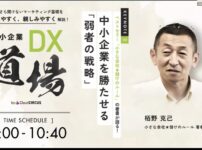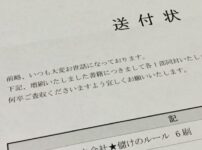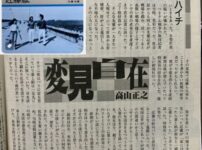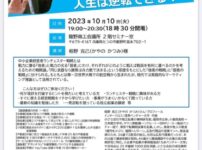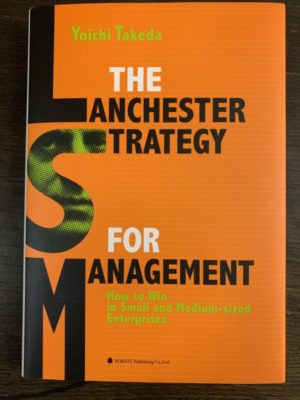
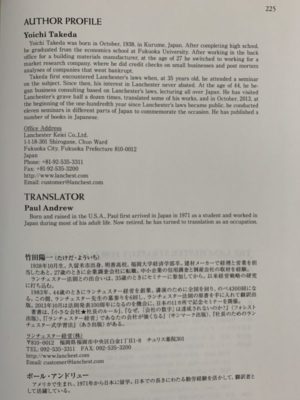
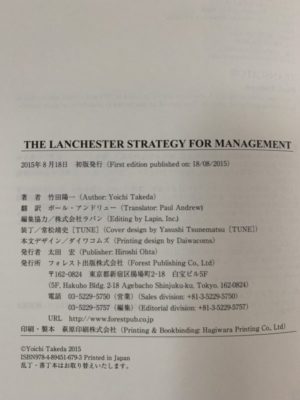

Foreword Let us agree that a small company, a principal subject in this book, means a company that employs no more than 100 workers. Now consider a small company where people are not paid fixed salaries, but by percentage. De- spite being surrounded by a number of large, strong companies, this little company receives no handicap like it might in golf. If it does not take certain actions to make up for its small scale and other unfavorable conditions, it will feel the pressure from its competitors and surely face an uphill battle. If this forces the company into a serious cash-flow problem, banks are not likely to help, let alone the government. Simply put, the world of business is one in which only the talented survive. But that is not all. In a small company, the president's business acumen determines at least 96 percent of the output, while the efforts of the other employees account for less than 4 percent. To improve performance in this kind of situation, the president must slavishly study and apply business strategies that would put his or her company into the top five out of a hun- dred competitors. Making it to the very top, of course, would be icing on the cake. If sole proprietorships are included, 94 percent of the companies in Japan have no more than 30 employees, and 98 percent have no more than 100 employees. The problem is, even if presidents of these sorts of companies want to learn effective business strategies, no one has been there to show them the way-at least no one who has focused on the problems specifically facing small companies. And so, without understanding that a president's role changes depending on the size of the company, most presidents plod on, not knowing the dif- ference between strategies and tactics. They simply believe that the tactics of handling the tasks at hand are the most important aspects of running a business. That is no way to operate an effective business, so performance will only suffer.
はじめにこの本の主要な主題である小さな会社は、100人以下の従業員を雇用する会社を意味することに同意しましょう。 ここで、人々が固定給ではなくパーセンテージで支払われる小さな会社を考えてみましょう。 多くの大企業に囲まれているにも関わらず、この小さな会社はゴルフのようなハンディキャップを受けません。 小規模およびその他の不利な条件を補うために特定のアクションを実行しない場合、競合他社からのプレッシャーを感じ、確実に困難な戦いに直面します。 これにより会社が深刻なキャッシュフロー問題に追い込まれた場合、政府は言うまでもなく銀行は助けにならないでしょう。 簡単に言えば、ビジネスの世界は、才能のある人だけが生き残る世界です。 しかし、それだけではありません。 小さな会社では、社長のビジネスの洞察力が出力の少なくとも96%を決定しますが、他の従業員の努力は4%未満を占めています。 この種の状況で業績を改善するには、社長は、自分の会社を何百もの競合他社のトップ5に入れるビジネス戦略を慎重に研究し、適用しなければなりません。 最上位に到達することは、もちろん、ケーキの上のアイシングになります。 個人事業主が含まれる場合、日本の企業の94%は従業員が30人以下で、98%は従業員が100人以下です。 問題は、これらの企業の社長が効果的なビジネス戦略を学びたいとしても、誰も彼らに道を示すことはありませんでした。少なくとも中小企業が特に直面している問題に焦点を当てた人は誰もいません。 だから、社長の役割は会社の規模に応じて変わることを理解せずに、ほとんどの社長は戦略と戦術の違いを知らずにplした。 彼らは単に、手元のタスクを処理する戦術がビジネスを運営する上で最も重要な側面であると信じています。 それは効果的なビジネスを運営する方法ではないため、パフォーマンスが低下するだけです。
One can of course find books or attend seminars that explain businese strategies, but most of them are based on running a company with 5.000 or so employees. Peter F. Drucker's books sell briskly in Japan, but most oe what he describes applies to large companies with 50,000 or more emplov. ees. In Search of Excellence, published in 1982 by Thomas J. Peters and Rob ert H. Waterman, was a best seller in Japan. But the companies introduced in that work also tend to be huge, on the order of 50,000 or even 100,000 workers. The president of a small company who reads these books will need to scale their ideas down by a factor of 500 or 1,000 to apply them properly. clearly not a realistic endeavor. In the United Kingdom or the United States, too, if sole proprietorships are included, roughly 95 percent or so of the companies have fewer than 100 employees. So, like Japan, these countries would also have the same sort of mismatch between people who explain business strategies and those who are on the receiving end. This has bothered me, so I decided to write this book for the presidents of small companies. This book first discusses certain essential components of organizing a business, then explains principles of profitability that fundamentally decide whether the company is making enough money or not. After that, this book covers strategies necessary to put these factors and principles into practice. The strategies are based on Lanchester's laws. These laws, promulgated by Frederick W. Lanchester on October 2nd, 1914, are epitomized by two formulae. Lanchester's laws were originally presented as laws of combat, but in Japan they have been adapted into "laws of competition." If one applies Lanchester's laws to business strategy, previously vague aspects of run- ning a business become clearer, so it becomes easy to apply them to actual business situations. When these laws are applied to business, the following things become clarified. First is the relationship between market share and profitability. Second, distinctions can be made between the "strategy of the strong" thát can be implemented by the company fulfilling the conditions necessary to be come top-ranked, and the "strategy of the weak" that must be implemented by those, including the second-ranked company, that have failed to meet those conditions. Third, specific weightings can be assigned to products, their marketne strategies and tactics, and other such important factors and attendant p0 cedures comprising a business. I believe that these ideas, which until now seem to have escaped the
もちろん、ビジネス戦略を説明する本を見つけたり、セミナーに参加したりすることもできますが、それらのほとんどは従業員5.000人程度の会社の経営に基づいています。 Peter F. Druckerの本は日本で好調に売れていますが、彼が説明するほとんどのoeは、50,000以上のエンプロフを持つ大企業に適用されます。 ええ。 1982年にThomas J. PetersとRob ert H. Watermanによって出版されたSearch of Excellenceでは、日本でベストセラーになりました。 しかし、その仕事で導入された企業は、5万人、さらには100,000人の労働者でさえ巨大になる傾向があります。 これらの本を読む小さな会社の社長は、それらを適切に適用するために、アイデアを500または1,000倍に縮小する必要があります。 明らかに現実的な試みではありません。 英国または米国でも、個人事業主が含まれる場合、企業の約95パーセント程度が100人未満の従業員を抱えています。 ですから、日本のように、これらの国々も、ビジネス戦略を説明する人々と受け手側にいる人々との間に同じ種類のミスマッチを持っているでしょう。 これは私を悩ませたので、中小企業の社長のためにこの本を書くことにしました。 この本は、ビジネスを組織するための特定の重要な要素を最初に説明し、次に会社が十分な収入を得ているかどうかを根本的に決定する収益性の原則を説明します。 その後、この本では、これらの要因と原則を実践するために必要な戦略について説明します。 戦略は、ランチェスターの法律に基づいています。 1914年10月2日にフレデリックW.ランチェスターによって公布されたこれらの法律は、2つの公式で要約されています。 ランチェスターの法律はもともと戦闘法として提示されていましたが、日本では「競争の法則」に適応されました。 ランチェスターの法律をビジネス戦略に適用すると、以前はビジネス運営の曖昧な側面が明確になり、実際のビジネス状況にそれらを適用することが容易になります。 これらの法律がビジネスに適用されると、次のことが明らかになります。 まず、市場シェアと収益性の関係です。 第二に、トップランクになるために必要な条件を満たした企業が実施できる「強い者の戦略」と、第二者を含むそれらが実施しなければならない「弱い者の戦略」とを区別することができます。 -これらの条件を満たしていないランク付けされた会社。 第三に、特定の重み付けを製品、その市場戦略と戦術、および他のそのような重要な要因とビジネスを構成する付随する手順に割り当てることができます。 これらのアイデアは、今まで逃げたように思われる
Foreword attention of guru consultants in the United Kingdom and the United States. constitute a novel approach. I frst encountered Lanchester's laws in 1973, when I was 35 years old, at a seminar in Fukuoka. I liked physics and used to assemble radios and televisions as a hobby, so these laws caught my attention. From that point on I started to explore how they might be applied to businesses. Twelve years later, on December 9th, 1985, during a trip to England to study Lanchester's laws in earnest, I visited Dr. Lanchester's grave. Visit- ing gravesites may not be a common custom in England, but if someone in Japan were to devote considerable effort to studying the teachings of a great person, he or she would likely visit that person's grave. During my trip, I was fortunate to meet John Fletcher, head of the library at Coventry University, who was collecting materials on Dr. Lanchester. He was kind enough to give me a book that Dr. Lanchester wrote on his laws. By translating it, I took my study of Lanchester's laws to a new level and became able to put this book together. This work is dedicated to Dr. Lanchester, who became my source of strength as a business consultant, and to former Coventry University chief librarians John Fletcher and Barry West, who not only once warmly wel- comed a weary traveler from the Far East, but also helped so much in locat- ing and making available materials on Dr. Lanchester.
英国および米国の第一人者コンサルタントの前書きの注意。 新しいアプローチを構成します。 1973年、35歳のとき、福岡でのセミナーでランチェスターの法律に出会いました。 私は物理学が好きで、ラジオやテレビを趣味として組み立てていたので、これらの法律は私の注意を引きました。 その時点から、私はそれらがビジネスにどのように適用されるかを探り始めました。 12年後の1985年12月9日、ランチェスターの法律を真剣に研究するためにイギリスを旅行中に、私はランチェスター博士の墓を訪れました。 墓地を訪れることはイギリスでは一般的な習慣ではないかもしれませんが、もし日本の誰かが偉大な人の教えを研究することにかなりの努力を払うならば、彼または彼女はその人の墓を訪れるでしょう。 旅行中、幸運なことに、ランチェスター博士の資料を集めていたコベントリー大学の図書館長であるジョン・フレッチャーに会いました。 彼は親切にしてくれて、ランチェスター博士が彼の法律について書いた本をくれました。 それを翻訳することで、私はランチェスターの法律の研究を新しいレベルに引き上げ、この本をまとめることができるようになりました。 この作品は、ビジネスコンサルタントとしての私の力の源となったランチェスター博士と、かつては極東から疲れた旅行者を温かく迎えてくれただけでなく、コベントリー大学の元図書館長ジョン・フレッチャーとバリー・ウェストに捧げられています。 博士は、ランチェスター博士の資料を見つけて入手するのにも非常に役立ちました。
Contents Foreword- CHAPTER 1: A General Perspective on Business and its Essential Components 1. A Scientific Approach to Solving Problems 10 2. A Company Survives on Gross Profit - 11 3. Eight Essential Components of a Business 15 4. How to Prioritize the Eight Essential Components of a Business- 17 a. Using Weights for Traveling Sales 17 b. Weighting Sales Versus Product 18 c. The Front Lines Versus the Back Office: A 4-to-1 Disparity 20 CHAPTER 2: The Principle of Profitability and Market Share - 22 Introduction –22 1. Three Milestones of Market Share – 23 2. The Relation Between Market Share and Profitability 24 3. Why Does Profit Accrue When Market Share Increases? 26 4. Three Big Activities in Sales 27 5. Five Reasons Why the Top Company's Profits Keep Increasing 6. Location Determines Profit from Annual Sales- 31 7. It All Depends on the President's Mettle CHAPTER 3: Procedures and Their Weightings 34 Introduction- 34 1. Military Procedures for Planning a Campaign- 2. Ambition, Objective, Goals 34 35 3. What Tactics Means 37 a. Roles of the Corporal and of the Tactical Leader 4. What Strategy Means –38 – 39 a. Principal Roles of a General (1) A general is confident of winning when entering a battle
目次序文-第1章:ビジネスとその必須コンポーネントに関する一般的な視点1.問題解決のための科学的アプローチ10 2.粗利益で生き残る会社-11 3.ビジネスの8つの必須コンポーネント15 4. 8つの優先順位付け方法 ビジネスの必須コンポーネント-17 a。 巡回セールスでのウェイトの使用17 b。 売上高と製品の重み付け18 c。 フロントラインとバックオフィス:4対1の格差20第2章:収益性と市場シェアの原理-22はじめに-22 1.市場シェアの3つのマイルストーン-23 2.市場シェアと収益性の関係24 3.市場シェアが増加すると利益が発生するのはなぜですか? 26 4.売上における3つの大きな活動27 5.トップ企業の利益が増加し続ける5つの理由6.場所は年間売上から利益を決定する-31 7.それはすべて社長の意志に依存する第3章:手順とその重み34はじめに-34 1.軍事行動計画-2.野望、目的、目標34 35 3.戦術の意味37 a。 Corp長と戦術的リーダーの役割4.戦略の意味–38 – 39 a。 将軍の主な役割(1)将軍は、戦闘に参加したときに勝利する自信がある
Contents (2) A general picks battles wisely (3) A general should have a clear and worthy cause when going to war 40 (4) A general gathers intelligence about the enemy 41 (5) A general going into battle must decide which weapons to use in the main and which to use as auxiliary: -41 (6) A general chooses where to fight and delineates the boundaries of the battlefield –41 (7) A general prudently selects a route for marching to the battlefield -42 (8) A general determines the battle formation when fighting is imminent -42 (9) A general organizes detachments and appoints officers- 43 (10) A general decides methods for education and training- (11) A general calculates the expenses of a campaign and decides how to obtain and allocate funds-44 (12) A general determines ways to maintain supplies of arms and provisions- - 45 (13) A general draws up a battle plan and conveys it to subordinates 45 b. Summary of the Roles of a General – 46 5. Duties to be Discharged by the President a. In Business, Be Like a General in Observing People - 47 b. Success is Determined by When the President Leaves the Front Lines-47 6. Most People Misunderstand Strategy 48 7. Weighting the Procedures - 50 8. Weights for the Whole Business 51 a. Overall View of a Business: Takeda Business Model -51 b. Weighting Elements of the Whole Company 52 9. With 30 Employees, the President Determines 98% of Performance -53 10. Pareto Principle Seen in the President's Power 54 CHAPTER 4: Principles of Lanchester's Laws- 1. Lanchester's Laws 56 2. Lanchester's Laws in Business 61 a. How to Increase Sales Performance 61 b. Floor Area and Sales in Department Stores 63 c. The Case of Hiroshima City- 63 d. The Case of Kumamoto - 64 3. Lanchester's Laws and Strategic Concepts-65 4. Two Strategic Concepts- a. Strategic Concepts for the Dominant Army 66 b. Strategic Concepts for the Lesser Army – 67 c. Business Strategy Concepts for the Strong
内容(2)将軍は賢明に戦いを選ぶ(3)将軍は戦争に行く際に明確で価値のある原因を持たなければならない40(4)将軍は敵に関する情報を集める41(5)戦いに行く将軍はどの武器を メインで使用し、補助として使用する:-41(6)将軍が戦う場所を選択し、戦場の境界線を描く–41(7)将軍は慎重に戦場へ行進するルートを選択する-42(8) 将軍は戦闘が差し迫っているときの戦闘形態を決定する-42(9)将軍は分遣隊を組織し、役員を任命する-43(10)将軍は教育と訓練の方法を決定する-(11)将軍はキャンペーンの費用を計算し、その方法を決定する 資金の獲得と配分-44(12)将軍は武器と食糧の供給を維持する方法を決定する-45(13)将軍は戦闘計画を作成し、それを部下45bに伝える。 将軍の役割の要約– 46 5.大統領によって解任される義務a。 ビジネスでは、人々を観察する際に一般のように-47 b。 成功は、大統領が最前線を去るときによって決まります-47 6.ほとんどの人が戦略を誤解する48 7.手順の重み付け-50 8.事業全体の重み51 a。 事業の全体像:武田ビジネスモデル-51 b。 会社全体の重み付け要素52 9.従業員30人で、社長は業績の98%を決定します-53 10.大統領の権限に見られるパレートの原則54第4章:ランチェスターの法の原則-1.ランチェスターの法56 2.ランチェスターの法 ビジネス61 a。 販売実績を増やす方法61 b。 デパートの床面積と売上高63 c。 広島市の場合-63 d。 熊本の事例-64 3.ランチェスターの法則と戦略的概念-65 4. 2つの戦略的概念-a。 支配軍の戦略的概念66 b。 小軍の戦略的コンセプト– 67 c。 強者のためのビジネス戦略コンセプト
Contents 3 d. Business Strategy Concepts for the Weak – 68 5. Market Share Separates the Strong from the Weak -69 a. The Difference between Strategic Attacks and Tactical Attacks -70 b. Two-Thirds Allocation to Strategic Attacks -71 pane c. Three Milestones of Market Share – 72 d. Three Milestones of Market Share, Absent from American Marketing 73 6. Three Conditions for Being Strong -74 7. The Law of the Death-Line-75 8. ABCS of the Weak Company-77 CHAPTER 5: Business Strategies of the Strong- 78 1. The Strong Company Aspires to be Number One on All Fronts 79 2. The Strong Company Emphasizes Products for Large-Scale Markets- 80 a. The Strong Company Gives Priority to Frequently Used Products 80 b. The Model of the Top Product is Periodically Renewed -81 3. The Strong Company Broadens Its Product Mix - 83 a. The Strong Company Makes Multiple Brands b. The Strong Company Develops New Products 84 c. The Strong Company Advances into Related Fields -85 4. The Strong Company Works in Big Cities 86 5. The Strong Company Extends Everywhere- 6. The Strong Company Uses All Distribution Channels-87 7. The Strong Company Targets Big Industries and Big Segments 87 8. The Strong Company Sells Indirectly Through Wholesalers - 88 9. The Strong Company Advertises in Mass Media - 68 10. The Strong Company Augments Quantity, Then Quality 06 11. The Strong Company Heads Off Weak Companies - 12. The Strong Company Retaliates When a Weak Company Introduces a New Product - 92 13. The Strong Company Does Business in a Suit of Armor-95 14. A Rising Star Needs the Product Strategy of a Strong Company- 15. The Strong Company May Actually Be a Hybrid -96 16. Wrap-up of Strategies of the Strong 95 – 97 CHAPTER 6: Business Strategies of the Weak 86 - Part 1: Setting a Weak Company's Goals 1. Shoot for the Stars 100 2. Have War Goals and Battle Goals 101 a. A Weak Company Lashing Out at a Strong Company Will Fail 101
目次3 d。 弱者のためのビジネス戦略コンセプト– 68 5.市場シェアは弱者と強者を分ける-69 a。 戦略的攻撃と戦術的攻撃の違い-70 b。 戦略的攻撃への2/3の割り当て-71ペインc。 市場シェアの3つのマイルストーン– 72 d。 市場シェアの3つのマイルストーン、アメリカのマーケティングなし73 6.強くなるための3つの条件-74 7.デスライン75の法則8.弱い会社のABCS-77第5章:強いのビジネス戦略78 1.強力な企業はすべての面でナンバーワンになることを目指す79 2.強力な企業は大規模市場向けの製品を重視する-80 a。 強力な会社が頻繁に使用する製品を優先する80 b。 トップ製品のモデルは定期的に更新されます-81 3.強力な企業が製品構成を拡大-83 a。 強い会社が複数のブランドを作るb。 強力な会社が新製品を開発84 c。 強い会社は関連分野に進出する-85 4.強い会社は大都市で働く86 5.強い会社はどこにでも広がる-6.強い会社はすべての流通チャネルを使用する-87 7.強い会社は大きな産業と大きなセグメントをターゲットとする87 8.強力な会社は卸売業者を通じて間接的に販売します-88 9.強力な会社はマスメディアで広告します-68 10.強力な会社は量を増やし、品質を向上させます06 11.強力な会社は弱い会社を避けます-12.強力な会社はいつ報復します 弱い会社が新製品を導入-92 13.強力な会社は鎧95のスーツでビジネスを行う14.注目株には強力な会社の製品戦略が必要-15.強力な会社は実際にはハイブリッドである可能性-96 16 。強力な戦略のまとめ95 – 97第6章:弱者のビジネス戦略86-パート1:弱い会社の目標を設定する1.星を狙う100 2.戦争の目標と戦いの目標を設定する101 a。 弱い会社が強い会社に打ち勝つと失敗する101
Contents b. A Weak Company Should Target a Doomed Company a. Be Distinet from Other Companies- 4. Be the Big Pish in a Small Pond a. Better then Being a Small Fish in a Big Pond - b. Learn about the Many Succesn Stories- e. The Way to the Top is Not in the Accounting Ledger - 5. Pind the Goals in the Details 6. Winnowing the Options to Reach the Top- a. How to Seleet the Best Product-114 b. How to Select the Best Region-115 e. Market Research for a Retail Store or Restaurant-117 d. How to Select the Best Industry or Customer Segment-118 7. Keep the Scope Limited- a. Scope of the Products- b. The Scourge of Too Many Products- c. Scope of the Business Region d. Track Profits District by District-125 e. Scope of Retail Stores and Restaurants-126 f. Scope of Industry and of Customer Segments-128 8. Get Directly to the End User 9. Gather First-Hand Intelligence--130 10. Wrap-up on Setting Goals- Part 2: Running a Weak Company 1. Make the Goal a Sure Thing-135 a. How to Achieve Victory Depends on Time Needed to Get There-135 b. Sack Workers from Unproductive Operations-137 e. Be Decisive or Forget it d. Success Stories-139 2. How to Do it Wrong- 3, Innovate, Inovate, Innovatel-143 4. Eradicating Nonsense-the Lite Company 5. Don't Show Your Hand to the Dealer- 150 113 -119 120 -122 -134 1142 6. Wrap-up on Running a Weak Company- Part 3: The Importance of Time on the Job-152 1. Enthusiastically Aspire to Make the Best Company-153 a. How an Active Person Thinks-154 b. How a Passive Person Thinks-155 c. Business Must Be in Active Mode to Be Viable-156
内容b。 弱い会社は運命の会社をターゲットにすべき 他の会社とは一線を画します-4.小さな池で大物になるa。 大きい池の小さな魚であることのほうが良い-b。 多くの成功物語について学ぶ-e。 トップへの道は経理台帳にはない-5.詳細に目標を固定する6.トップに到達するためのオプションを選別する-a。 最高の製品を選択する方法-114 b。 最適な地域の選択方法-115 e。 小売店またはレストランの市場調査-117 d。 最適な産業または顧客セグメントの選択方法-118 7.範囲を制限する-a。 製品の範囲-b。 多すぎる製品の惨劇-c。 事業地域の範囲d。 District-125による利益地区の追跡e。 小売店およびレストランの範囲-126 f。 産業および顧客セグメントの範囲-128 8.エンドユーザーに直接連絡する9.直接のインテリジェンスを収集する-130 10.目標設定のまとめ-パート2:弱い会社の運営1.目標を確実にする モノ-135 a。 勝利を達成する方法は、そこに到達するのに必要な時間に依存する-135 b。 非生産的作業からの袋労働者-137 e。 決定的であることまたはそれを忘れてくださいd。 Success Stories-139 2.方法の誤り-3、Innovate、Inovate、Innovatel-143 4. Nonsense-the Lite Companyの撲滅5.ディーラーに手を見せないでください-150 113 -119 120 -122 -134 1142 6.弱い会社の運営のまとめ-パート3:仕事の時間の重要性-152 1.熱心に最高の会社を作ることを熱望する-153 a。 アクティブな人の考え方-154 b。 受動的な人の考え方-155 c。 ビジネスが実行可能になるにはアクティブモードでなければならない-156
Contents 2. The Early Bird Catches the Worm a. Use a Time Strategy that Makes Success Certain- 157 158 b. Show up at Work by Seven-Thirty 159 3. Using Time Effectively - a. The President is Responsible for Allocating Time 091 - b. A Formula for Learning Effectiveness 4. Arguments Against the Time Strategy - 164 5. Elements of Time Management and Their Weights- 991 6. Keep Persevering Until the Goal is Attained - a. Most People Give up Before a Competitive Product Is Ready- 991 b. Getting a New Product onto Market Shelves Takes Time 167 7. Time Strategy Changes into Ambition and Passion 8. People Brought up in Adversity Know Strategies of the Weak- 9. Don't Be Intoxicated by a Little Success 691 – 170 10. Wrap-up on the Importance of Time on the Job – 174 173 11. What This Whole Book Comes Down To - a. The Widely Applicable Strategies of the Weak 174 b. The President's Effectiveness Shows Up in the Bottom Line 174 Postscript - 177 About Frederick W. Lanchester 179 Bibliography 180 Appendices - 181 1. Annual Gross Profit Per Employee for Small Businesses- 2. Annual Net Profit Per Employee for Small Businesses 3. Excerpt from Aircraft in Warfare- 182 184 - 4. Biography of F. W. Lanchester 208
目次2.アーリーバードがワームをキャッチa。 成功を確実にする時間戦略を使用する-157 158 b。 Seven-Thirty 159による職場での登場3.時間を効果的に使う-a。 大統領は時間091を割り当てる責任があります-b。 有効性を学習するための公式4.時間戦略に反する議論-164 5.時間管理の要素とその重み-991 6.目標が達成されるまで忍耐し続ける-a。 競争力のある製品が完成する前にほとんどの人がGiveめる-991 b。 市場の棚に新製品を入れるには時間がかかります167 7.野望と情熱への時間戦略の変更8.逆境で育った人々-弱者の戦略を知っている-9.小さな成功に酔わないでください691-170 10.ラップ- 仕事上の時間の重要性について-174 173 11.この本全体がどうなるか-a。 広く適用可能な弱い戦略174 b。 社長の有効性は最終結果に現れる174追記-177フレデリック・W・ランチェスターについて179参考文献180付録-181 1.中小企業の従業員一人当たりの年間総利益-2.中小企業の従業員一人当たりの年間純利益3.航空機からの抜粋 戦争で182 184-4. FWランチェスター208の伝記
CHAPTER 1: A General Perspective on Business and its Essential Components CHAPTER 1: A General Perspective on Business and its Essential Components 1. A Scientific Approach to Solving Problems In order for a small company, considered here to be a company of no more than 100 people, to improve its performance and become highly regarded by its peers and suppliers, it first needs to have a no-frills business model containing both goals befitting a company of its size, as well as ways to reach those goals. The employees do their jobs by fitting in with the business model. If the president's model makes sense, they work efficiently and the company per- forms well. Conversely, with a poor business model, the employees work inefficiently and performance declines. The company's performance thus de- pends greatly on the results of the business model that the president puts in place. This can be seen in the company's profit per employee. If the profit per employee is two or three times the industry's average, the president's busi- ness model is top-class in that industry. If instead the profit per employee is low or negative, something is seriously wrong with the business model and it needs to be revamped. If business is lackluster because things are just not taking shape, figuring out what part of the business model is wrong may not be easy. In this type of situation, revising the business model to improve performance may require some soul-searching and the painful process of rethinking just what a busi- ness actually is. At these times, it is imperative that the following must be done. First, the president must step back in order to clearly see the big picture of running his or her business. If the conception of the big picture is mistaken, everything that ensues from it will go awry, so it pays to take enough time to think about the whole business and carefully view it from various angles. the dn business. These components become important elements when creating the Second, understand how certain "essential components" make
第1章:ビジネスとその重要なコンポーネントに関する一般的な視点第1章:ビジネスとその重要なコンポーネントに関する一般的な視点1.問題を解決するための科学的アプローチ 人々、そのパフォーマンスを改善し、同業者やサプライヤーから高く評価されるためには、まず、その規模の会社にふさわしい目標と、それらの目標を達成する方法の両方を含む、シンプルなビジネスモデルが必要です。 従業員は、ビジネスモデルに適合することで仕事をします。 社長のモデルが理にかなっている場合、彼らは効率的に働き、会社はうまく機能します。 逆に、貧弱なビジネスモデルでは、従業員の作業効率が低下し、パフォーマンスが低下します。 したがって、会社の業績は、社長が定めたビジネスモデルの結果に大きく依存します。 これは、従業員あたりの会社の利益に見ることができます。 従業員1人あたりの利益が業界の平均の2〜3倍であれば、社長のビジネスモデルはその業界でトップクラスです。 代わりに、従業員1人あたりの利益が低いかマイナスである場合、ビジネスモデルに何か重大な問題があり、改善する必要があります。 物事が形になっていないためにビジネスが不活発な場合、ビジネスモデルのどの部分が間違っているかを把握することは容易ではないかもしれません。 この種の状況では、パフォーマンスを改善するためにビジネスモデルを修正するには、ソウルサーチと、ビジネスが実際に何であるかを再考する痛みを伴うプロセスが必要になる場合があります。 このような場合、次のことを行う必要があります。 最初に、社長は自分のビジネスを運営することの全体像を明確に見るために後退しなければなりません。 全体像の概念が間違っていると、そこから生じるすべてがおかしくなりますので、ビジネス全体について考え、それをさまざまな角度から注意深く見るのに十分な時間を費やすことが重要です。 dnビジネス。 これらのコンポーネントは、第2を作成するときに重要な要素になり、特定の「必須コンポーネント」がどのように作成されるかを理解します
CHAPTER 1: A General Perspective on Business and its Essential Components 11 business model, so they need to be clearly articulated. Third, these essential components need to be prioritized, so weight must be assigned to each one to indicate its relative importance. Fourth, a "principle of profitability" needs to be clearly applied, as it fun- damentally determines whether the company can make money or not. This is a very important operation, not to be lightly skipped over. Fifth, an action plan is vital to bring all of these ideas to fruition, and it must be laid out in detail. Sixth, all of the details in the action plan need to be assigned weights so that everyone knows where the priorities lie. If the business model is improved and revised by following these steps and vigorously put into action with the help of the employees, the resulting high caliber of work will be effective in improving the company's performance. Let's face it. Completing all six of these steps correctly requires a lot of time and might be quite unpleasant. But as the saying goes, "The longest way round is the shortest way home," and if the business model is really to be improved or rebuilt, each one of these steps must be painstakingly taken care of first. Only then will performance improve quickly. This is basically a scientific approach to solving problems. A scientist looks at a problem and forms a basis for breaking it down into component parts. Any serious problem in the real world is large and complex, so it needs to be parsed into components that reveal different aspects of that complexity. Each of the components can be dealt with more readily than the amorphous whole. When the parts are all taken care of they are then integrated back into the whole, which should no longer be as problematic as it first was. These are the fundamentals of the scientific approach to problem solving. Now, let's get started on this six-step journey. 2. A Company Survives on Gross Profit The first thing to do is get an overall picture of the whole business. But as I explained earlier, the core of a business does not have a clear shape and may be difficult to grasp. Furthermore, this sort of process becomes a matter of assessing quality, and quality becomes more difficult to perceive the higher it gets, further muddying the waters. One should thus try to get a proper feel for the business by approaching it with an empty mind, free of insistences, beliefs, or biases. A number of things can come along in a presi- dent's career to short-circuit thinking or have it progress in an unproductive airection. The worst thing is for a president to develop an obsession with
第1章:ビジネスとその重要なコンポーネント11ビジネスモデルの一般的な観点。したがって、それらは明確に表現される必要があります。 第三に、これらの重要なコンポーネントには優先順位を付ける必要があるため、相対的な重要性を示すために各コンポーネントに重みを割り当てる必要があります。 第4に、「収益性の原則」を明確に適用する必要があります。これは、会社が収益を上げることができるかどうかを基本的に決定するためです。 これは非常に重要な操作であり、軽くスキップしないでください。 第5に、これらすべてのアイデアを実現するためにアクションプランが不可欠であり、詳細にレイアウトする必要があります。 第6に、優先順位がどこにあるかを誰もがわかるように、アクションプランのすべての詳細に重みを割り当てる必要があります。 これらの手順に従ってビジネスモデルを改善および改訂し、従業員の力を借りて積極的に行動を起こせば、結果として得られる高い仕事量は会社の業績の改善に効果的です。 それに直面しよう。 これらの6つのステップをすべて正しく完了するには多くの時間が必要であり、非常に不快かもしれません。 しかし、「最も長い道のりは最短の帰り道です」ということわざにあるように、ビジネスモデルを実際に改善または再構築する場合は、これらの各手順を最初に慎重に行う必要があります。 その場合にのみ、パフォーマンスがすぐに向上します。 これは基本的に問題を解決するための科学的なアプローチです。 科学者は問題を見て、それを構成要素に分解するための基礎を形成します。 現実の世界における深刻な問題はどれも大きく複雑であるため、その複雑さのさまざまな側面を明らかにするコンポーネントに解析する必要があります。 各コンポーネントは、アモルファス全体よりも簡単に処理できます。 部品がすべて世話されると、それらは全体に統合され、最初のように問題はなくなります。 これらは問題解決への科学的アプローチの基本です。 それでは、この6ステップの旅を始めましょう。 2.粗利益で存続する会社最初に行うことは、事業全体の全体像を把握することです。 しかし、前に説明したように、ビジネスの中核は明確な形ではなく、把握するのが難しい場合があります。 さらに、この種のプロセスは品質を評価する問題になり、品質が高くなるほど品質を知覚することが難しくなり、水がさらに濁ります。 したがって、主張、信念、または偏見のない空虚な心でビジネスにアプローチすることにより、ビジネスの適切な雰囲気を取得しようとする必要があります。 大統領のキャリアの中で、思考を短絡させたり、非生産的な選挙で進歩させたりする多くのことが起こります。 最悪のことは、大統領が強迫観念を抱くようになることです。
To be continue



